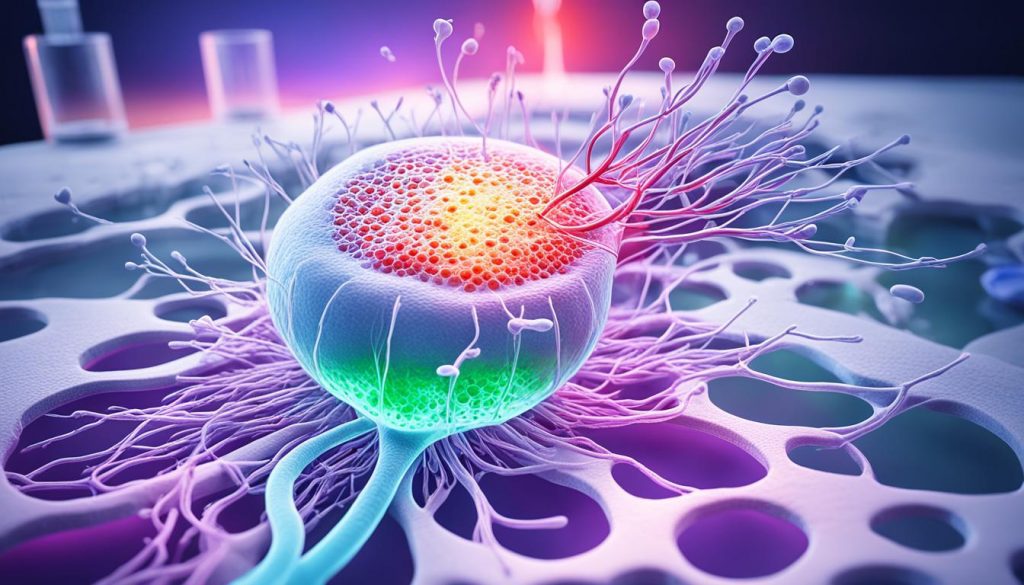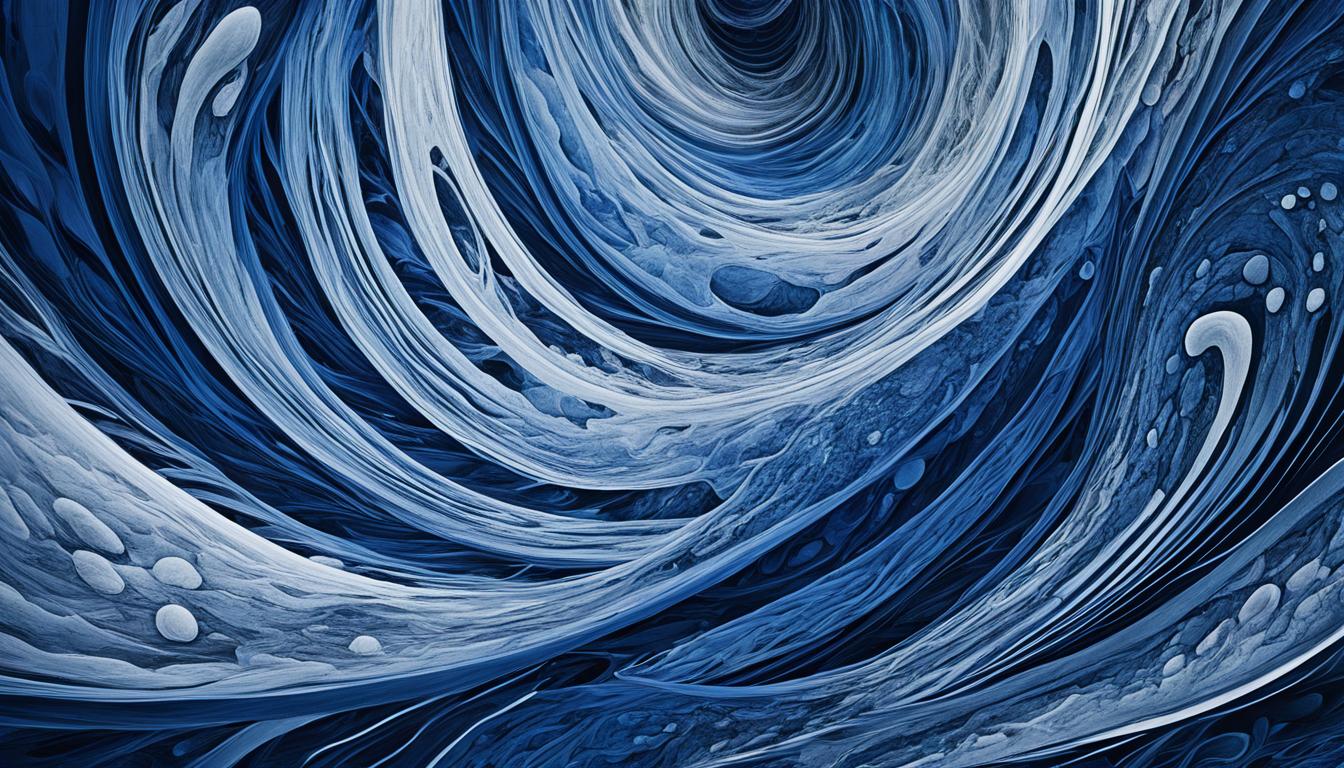Bladder calculi, also known as urinary calculi or kidney stones in the bladder, lead to major discomfort if not treated. It’s crucial to know about their symptoms, causes, and how they’re diagnosed and treated. This knowledge helps manage the condition effectively.
Key Takeaways:
- Bladder calculi form hard deposits in the bladder, causing symptoms like belly pain, having to urinate often, and finding blood in your pee.
- They often happen because of urinary tract infections, blockages at the bladder’s exit, or specific health issues.
- Doctors usually find them using imaging tests like ultrasounds or CT scans. You can treat them with medicine or surgery.
- Stem cell therapy is an exciting new treatment. It uses mesenchymal stem cells to help repair tissue and lessen swelling.
- We need more studies and trials to be sure stem cell therapy is safe and effective for bladder calculi in the long run.
Bladder Calculi Symptoms
Bladder calculi, also known as bladder stones or urinary calculi, have symptoms that can change. These changes depend on how big and where the stones are. Knowing these symptoms is key to getting the right medical help. Here are some common signs of bladder calculi:
1. Abdominal pain or discomfort
If you have bladder stones, you might feel pain or discomfort in your abdomen. This pain can range from mild to very bad. It might be constant or come and go. Where you feel the pain can change based on where the stones are in the bladder.
2. Frequent and urgent urination
Bladder stones can make the inner lining of the bladder irritated. This leads to needing to pee often and suddenly. You might find yourself needing to go to the bathroom more than usual. There’s also a strong feeling that you have to pee right away.
3. Pain or burning sensation during urination
Having bladder stones can make peeing painful or cause a burning feeling. This happens because the stones irritate and inflame the urinary tract. It can make peeing a discomforting experience.
4. Cloudy or bloody urine
Bladder stones can also change how your urine looks. Your urine might get cloudy because of particles or sediments from the stones. If the situation is more serious, your urine could have blood in it. This suggests that the bladder is irritated or hurt by the stones.
5. Difficulty starting or stopping urination
When bladder stones block urine flow, starting or stopping peeing can be hard. You might struggle to begin peeing or find it impossible to fully empty your bladder. This blockage can make going to the bathroom difficult.
6. Urinary incontinence
Sometimes, bladder stones lead to urinary incontinence. This means you can’t control your pee flow. It can cause the unexpected release of pee, especially when you’re active, coughing, or sneezing.
Not everyone with bladder stones will have symptoms. Sometimes, doctors find the stones by accident during check-ups or tests. If you think you might have bladder calculi, especially if you notice any symptoms, see a healthcare professional.
Causes of Bladder Calculi
Various factors cause bladder calculi. Knowing these reasons helps manage and stop them from happening again. The key causes are:
- Urinary Tract Infections (UTIs): UTIs create conditions that make minerals and salts turn into bladder stones.
- Bladder Outlet Obstruction: If urine flow is blocked, stones can form. Enlarged prostate, strictures, and neurogenic bladder are usual causes.
- Urinary Bladder Diverticulum: A bladder wall outpouching traps urine, leading to stones.
- Lifestyle Factors: Not drinking enough water and a poor diet increase risk. Dehydration causes concentrated urine, while bad diets change urinary pH, aiding stone creation.
To lower the risk of bladder calculi, tackle these causes and take preventive steps. This can boost urinary health overall.
Prevention Strategies for Bladder Calculi
Preventing bladder stones means living healthy and managing risks. Here are key strategies:
- Stay Hydrated: Drinking lots of water keeps you hydrated. It helps prevent stones by diluting your urine.
- Eat a Balanced Diet: Eating fruits, vegetables, and whole grains helps. Avoid too much processed food, salt, and animal proteins to keep a healthy urinary pH and lower stone risk.
- Manage Underlying Medical Conditions: Deal with UTIs, enlarged prostate, bladder diverticulum, and bladder issues to prevent stones.
- Practice Good Hygiene: Keeping clean reduces UTI risk, which can lead to stones.
- Seek Prompt Medical Attention: If you think you have bladder stones, see a doctor quickly for the right treatment.
By following these steps and choosing positive habits, you can cut down your risk of bladder stones. This promotes good urinary health.
Diagnosis of Bladder Calculi
To diagnose bladder calculi, doctors look at the patient’s medical history and do a physical check-up. They also use imaging tests. They aim to find out if there are stones in the bladder. They also see how serious the condition is.
The doctor will ask about symptoms and any past issues with bladder stones. This chat helps guess if there are bladder stones and why they might be there.
A hands-on exam is key for finding bladder stones. The doctor might feel the belly area to spot pain or odd signs. For men, checking the prostate is common to rule out other issues.
Imaging tests are central in seeing where stones are and how many. Ultrasound is a top choice because it’s easy and shows stones well. It lets doctors see the bladder in real time. This means they can spot the size and place of stones.
If things are complicated, a CT scan or X-ray might be needed. These give a clearer view of the bladder and nearby areas. They also show if there are any complications or other problems linked to the stones.
Sometimes, testing the urine can show blood, infections, or other odd signs. This helps doctors be more sure about bladder stones.
Doctors use your medical history, a physical check-up, and imaging tests to diagnose bladder calculi. This lets them make a treatment plan just for you.
Possible Imaging Tests for Diagnosing Bladder Calculi:
- Ultrasound: A non-invasive imaging method that visualizes the bladder and stones using sound waves.
- CT Scan: Provides a detailed cross-sectional view of the bladder, allowing for precise detection and characterization of bladder stones.
- X-ray: Can be used to identify the presence and location of bladder stones, especially if they contain calcifications.
Treatment Options for Bladder Calculi
The treatment of bladder calculi looks at the size, number, and location of the stones. It also considers if there are symptoms. Small stones without symptoms may not need treatment. They can pass by themselves. When treatment is needed, options include:
- Medications: Drugs like alpha-blockers can make bladder muscles relax. This helps the stones to pass.
- Minimally invasive procedures: Methods such as laser lithotripsy or cystolitholapaxy break up or remove stones. This is done with special tools without big cuts.
- Surgery: For bigger or complicated cases, open surgery might be necessary to take out the stones.
Talking with a healthcare professional is key to choose the right treatment for bladder calculi. They will look at the stones’ details and your health to give tailored advice.
Comparative Analysis of Treatment Options for Bladder Calculi
| Treatment Option | Advantages | Disadvantages |
|---|---|---|
| Medications | – Non-invasive – Effective for smaller stones – Low risk of complications |
– May take time – Not for all stone types – Possible side effects |
| Minimally invasive procedures | – Quick and effective – For larger stones – Minimal scarring |
– Might need several sessions – Risk of infection or injury – Costs more than medications |
| Surgery | – Removes stones completely – For complex/large stones – Quick symptom relief |
– Risky and invasive – Long recovery – More expensive than other methods |
Choosing a treatment option depends on stone size and location, overall health, and personal preferences. It’s vital to talk about benefits and downsides with your doctor. This helps in making a well-informed choice.
Stem Cell Therapy for Bladder Calculi
Stem cell therapy might change how we treat bladder stones. It uses mesenchymal stem cells (MSCs). These cells can turn into bladder cells. Studies show MSCs could help new bladder tissue grow. They might also lower inflammation caused by the stones.
Mesenchymal stem cells come from bone marrow, fat, and umbilical cord blood. Scientists want to use them to fight the root causes of bladder stones. This could give patients lasting relief.
The exact way stem cell therapy helps with bladder stones is still under research. But, signs are good that MSCs can calm inflammation. They seem to help with healing and growing new cells. This makes stem cell therapy a promising choice for bladder stone treatment.
Combination with Regenerative Techniques
Pairing MSCs with regenerative techniques is being looked into. Things like scaffolds or growth factors could improve results. This approach aims to create a good environment for the cells. It would help them attach, grow, and turn into healthy bladder tissue.
Using MSCs with scaffolds gives structure. It also guides tissue growth, making strong bladder tissue. Growth factors help cells grow and change faster. This speeds up healing and might make treatment better.
More studies and trials are needed to check if stem cell therapy for bladder stones is safe and works well. But, early results are hopeful. This new treatment could offer patients new choices and a better life.

| Treatment | Advantages | Challenges |
|---|---|---|
| Stem Cell Therapy | – Potential for tissue regeneration – Reduced inflammation |
– Safety concerns – Standardization of protocols |
| Combination with Regenerative Techniques | – Enhanced effectiveness – Improved tissue integration |
– Complex procedure – Long-term effects |
| Traditional Treatment Approaches | – Established protocols – Wide availability |
– Invasive procedures – Potential complications |
Even though new treatments like stem cell therapy seem helpful, standard treatments for bladder stones are still useful. Doctors look at many factors when choosing the best treatment. What works best depends on the patient’s specific situation.
Conclusion
Bladder stones are common and can cause major discomfort and health issues if not treated. It’s important to diagnose them quickly. Imaging tests are key in spotting the stones’ presence and place. The treatment varies based on how serious the disease is. There are medicines, less invasive procedures, and surgeries.
In the last few years, stem cell therapy has become a hopeful method for treating bladder stones. It uses the healing power of mesenchymal stem cells. This approach is new and appears to work well. But, more studies and trials are needed to check its safety and effectiveness over time.
Medical tech is always getting better, offering new ways to treat bladder stones. Stem cell therapy could change how we handle this disease. It offers a chance for better results and a higher quality of life for people with bladder stones.

